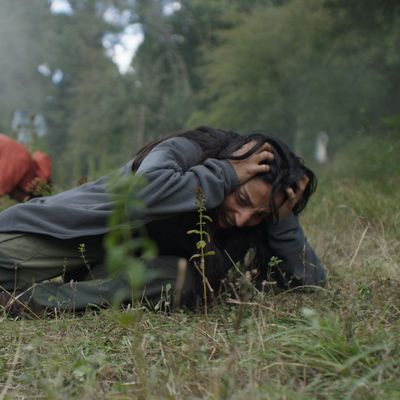
The characters of In the Earth are living through a pandemic that may or may not be our own. Some aspects of it are familiar, while others aren’t at all. When scientist Martin Lowery (Joel Fry) arrives at Gantalow Lodge, he is greeted by two men wearing face masks and a figure in full protective gear who, with routine efficiency, sprays him down next to a spot labeled “Disinfection Point.” The building is a vacation site that has been requisitioned during lockdown as a base for some research projects being conducted in the surrounding woods, and the unsettling emptiness of this usually bustling space is recognizable even as the barrage of medical tests Martin is immediately subjected to is not. But what really resonates is the skittishness of the characters, the way their conversations have a rustiness to them and the rhythms of their interactions are a little off. They aren’t just out of practice after a stretch of isolation — they’ve learned to instinctively distrust the proximity of other people.
In the Earth is the latest contribution to the small questionable canon of COVID cinema, having been shot by writer-director Ben Wheatley quietly over 15 days in August of last year. Movies so far have struggled with how to tell stories about life lived under the shadow of a virus, but one thing In the Earth is unusually good at is summoning a sense of shared but unevenly distributed trauma across its small set of characters. Martin, we learn, has suffered significant personal losses because of the pandemic and comes across as someone whose personality has been eroded by long stretches of grieving in solitude. He’s bumbling, a city-boy scientist who reluctantly embarks on a two-day hike to a research site in the company of the far more competent park ranger Alma (Ellora Torchia). But his unassuming oafishness feels as much like the result of his having gone numb as it does any of his innate inexperience in the field — he lumbers like someone whose limbs are still asleep after they have been slept on awkwardly. It doesn’t take long for circumstances to demand that he snap to attention, as the pair encounter an ominous abandoned campsite, get attacked in their tents at night and then encounter a man named Zach (Reece Shearsmith), who provides a reminder that contagion isn’t the only reason one might have to be wary of strangers.
Wheatley is one of those filmmakers whose reputations have outstripped their bodies of work. His sophomore breakout, Kill List, about a soldier turned soldier of fortune who takes a job with occult elements, is still the only one of his films that is wholly successful. In the Earth is positioned to be a return to form after the disaster that was his adaptation of Rebecca for Netflix last year — a scrappy production made while the world was on pause. But after its evocative introduction, In the Earth ends up in comfortable, disappointingly underdeveloped territory for the director, incorporating some of Kill List’s folk-horror undercurrents and A Field in England’s psychedelia while borrowing freely from The Blair Witch Project. Both Zach and Olivia Wendle (Hayley Squires), the out-of-contact colleague Martin has been trying to locate, turn out to have been in the woods too long. The two are trying to communicate with what they are convinced is a spirit in the forest, maybe related to the mycorrhizal network connecting the plant life underground, or maybe related to a man in the past who was accused of necromancy and used his mystical knowledge to transfer himself into a stone that has a hole bored through it.
Eh, whatever. It’s not worth trying to square these beliefs in the expectation that there will be some greater reveal, because there isn’t one. The film rattles apart as it goes along until it resorts to a couple of hallucinatory freakout sequences in place of an ending. But In the Earth is deflating not just because it runs out of gas and ideas so quickly and relies on a scattering of disturbing imagery — like paper cutouts put over a character’s eye, a close-up of an ax being taken to a body part, and someone bent over a soundboard in the woods like a Druidic DJ — to make up for its hollowness. It’s also a waste for never managing, after that reverberant opening, to link its vision of the pandemic to its central story in any substantive way. COVID has proven a difficult subject for fiction, but In the Earth feels as though it sets up an emotional parallel that it doesn’t follow through on, abandoning the virus as a backdrop for a horror story that’s slapdash and never very creepy. It’s another instance of pandemic cinema that feels as if it could use more distance to figure out what it wants to say.





